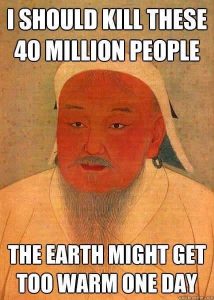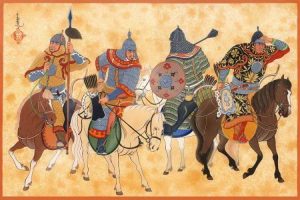20 Incredible Facts You Never Knew About Genghis Khan

Photo Credit: www.dailymail.co.uk
By Chidiebere Kalu
Wait, you mean you’ve not heard of Genghis Khan? The great conqueror?
Well, he was the founder of the Mongol Empire, which became the largest contiguous empire in history.
Genghis Khan’s Empire spanned many modern countries, and even continents. From Eastern Asia into Eastern Europe, Genghis Khan amassed one of the largest empires history has ever seen. Seriously you need to know about this guy
So here are 20 jaw-dropping, wtf-itude, are-you-serious?, oh-my-god and incredible FACTS about the greatest conqueror to ever step his foot on earth.
- Truth is, “Genghis” was not his real name
The man who would become the “Great Khan” of the Mongols was born along the banks of the Onon River sometime around 1162 and originally named Temujin, which means “of iron” or “blacksmith.” He didn’t get the honorific name “Genghis Khan” until 1206, when he was proclaimed leader of the Mongols at a tribal meeting known as a “kurultai.” While “Khan” is a traditional title meaning “leader” or “ruler,” historians are still unsure of the origins of “Genghis.” It may have meant “ocean” or “just,” but in context it is usually translated as “supreme ruler” or “universal ruler.”
- Blood Oath
Legend has it that Genghis Khan was born with a blood clot clenched in his fist, foretelling his emergence as a great and powerful leader.
Looks like he had blood on his hands from the very beginning. *winks*

- Man Of The House
When Genghis Khan was just 10 years old, his father Yesugei was poisoned by a rival tribe (Tatars) for stealing and marrying Genghis Khan’s mother, Hoelun.
The Mongol Empire went on to become the largest contiguous empire in history, stretching from the Pacific Ocean to eastern Europe.
Lemme explain.
I mean his empire included modern day Mongolia, most parts of China, Korea, Pakistan, Iran, Iraq, Turkey, Afghanistan, Moldova, Kazakhstan, Armenia, Georgia, Turkmenistan, Kuwait, Kyrgyzstan, Tajikistan, Uzbekistan, and some parts of Russia.
Incredible, huh?
- There is no definitive record of what he looked like.
For such an influential figure, very little is known about Genghis Kahn’s personal life or even his physical appearance. No contemporary portraits or sculptures of him have survived, and what little information historians do have is often contradictory or unreliable.
He never allowed anyone to paint his portrait, sculpt his image or engrave his likeness on a coin. The first images of him appeared after his death.
Most accounts describe him as tall and strong with a flowing mane of hair and a long, bushy beard. Perhaps the most surprising description comes courtesy of the 14th century Persian chronicler Rashid al-Din, who claimed Genghis had red hair and green eyes. Al-Din’s account is questionable—he never met the Khan in person—but these striking features were not unheard of among the ethnically diverse Mongols.
Who needs a selfie?
- Some of his most trusted generals were former enemies.
The Great Khan had a keen eye for talent, and he usually promoted his officers on skill and experience rather than class, ancestry or even past allegiances.
One famous example of this belief in meritocracy came during a 1201 battle against the rival Taijut tribe, when Genghis was nearly killed after his horse was shot out from under him with an arrow. When he later addressed the Taijut prisoners and demanded to know who was responsible, one soldier bravely stood up and admitted to being the shooter. Stirred by the archer’s boldness, Genghis made him an officer in his army and later nicknamed him “Jebe,” or “arrow,” in honor of their first meeting on the battlefield.
Along with the famed general Subutai, Jebe would go on to become one of the Mongols’ greatest field commanders during their conquests in Asia and Europe.
- No one knows how he died or where he is buried
Of all the enigmas surrounding the Khan’s life, perhaps the most famous concerns how it ended.
No one knows where the great Genghis Khan was buried. There are no official records, and anyone who knew where it was took the secret to their graves. He ensured this by having his entire funeral precession killed by 800 soldiers after he was buried. Later, those 800 soldiers were killed.
Genghis Khan is said to have had those he trusted most to divert a river over his final resting place to ensure no one would disturb his eternal slumber. Now he sleeps with the fishes.

- He was responsible for the deaths of as many as 40 million people.
While it’s impossible to know for sure how many people perished during the Mongol conquests, many historians put the number at somewhere around 40 million. Censuses from the Middle Ages show that the population of China plummeted by tens of millions during the Khan’s lifetime, and scholars estimate that he may have killed a full three-fourths of modern-day Iran’s population during his war with the Khwarezmid Empire. All told, the Mongols’ attacks may have reduced the entire world population by as much as 11 percent.
The Mongol invasions effectively cooled the planet, scrubbing around 700 million tons of carbon from the atmosphere.
The deadliest war in the history was WWII, but the Mongol Invasions are a close second, despite occurring 700 years earlier, when the world’s population was only a fifth of what it was in 1945. In earnest, he killed more people than Hitler and Stalin.
There was even a time the Mongols celebrated a victory over the Russians by laying survivors on the ground, dropping a heavy wooden gate on them, and then having a victory banquet on top of it while the victims suffocated and were crushed to death.
Khan had rules against spilling noble blood over the ground. Instead, they used loopholes like making them bend backward until their backbones snapped, pouring molten silver into eyes and ears, and being rolled up in a rug and trampled to death by the Mongol cavalry.
I don’t need know if I should this one sha but, in his youth, Genghis Khan actually killed his half-brother Bekhter for not sharing food.
- Genghis Khan created the first international postal service, allowing people to mail parcels and letters to friends and family in other countries without having to hire specialized couriers. The postal service was similar to the American Pony Express and used over 50 000 horses.
This medieval express consisted of a well-organized series of post houses and way stations strung out across the whole of the Empire. By stopping to rest or take on a fresh mount every few miles, official riders could often travel as far as 200 miles a day. The system allowed goods and information to travel with unprecedented speed, but it also acted as the eyes and ears of the Khan. Thanks to the Yam, he could easily keep abreast of military and political developments and maintain contact with his extensive network of spies and scouts. The Yam also helped protect foreign dignitaries and merchants during their travels. In later years, the service was famously used by the likes of Marco Polo and John of Plano Carpini.

- He was tolerant of different religions
Genghis Khan was tolerant of individual beliefs, encouraging religious freedom amongst his subjects. It didn’t matter who you believed in, because Genghis Khan believed in you.
There was even a time inn 1254 C.E. when he organized a formal religious debate between teams of Christians, Muslims, and Buddhists. The debate went on for multiple rounds on a variety of theological topics until the participants became so drunk that it concluded without any clear winner.
- Golden Heart.
Genghis Khan was a brutal warlord, but also a generous ruler. He was among the first global leaders to exempt the clergy and the poor from taxation.
He also encouraged literacy, and established a free religion.
But don’t get it twisted tho, these acts led many people to join his empire before they were even conquered.
What a clever man!
- Be fruitful and multiply
Genghis Khan is the most successful biological father of all time, with nearly 16 million direct descendants.
As a matter of fact, nearly 8% of Asian men are descended from Genghis Khan. That’s nearly 350 million men with one common ancestor.
- Feminist
Women were also well respected in the Mongolian Empire, with Töregene Khatun ruling as regent for 5 years after the death of Genghis’ son, Ögedei.
- Like Father Like Sons
Genghis Khan had 4 legitimate sons, all of whom heavily participated in the Mongol conquests. His third son, Ogedei became the Khan when Genghis finally died, and continued his father’s conquests of Asia and Europe.
Don’t you hate it when your parents force you into the family business?
- First Lady of Life
Though Genghis Khan took many wives throughout his life, his only Empress was his first wife Börte.

- Master Planner
Genghis Khan was a master tactician, often employing clever tricks to defeat his enemy. Some examples include false retreats to bait enemies into ambushes, and tying sticks to their horses’ tails to kick up dust storms equal to those kicked up by large armies.
Genghis Khan was almost always outnumbered during battles, but found creative solutions to obtaining victory.For example, Genghis Khan invaded China with 90,000 troops and defeated an army of 1 million plus soldiers. He killed nearly 500,000 soldiers while a great many more, including generals and high ranking officers defected to the Mongols. It’s now about the size of your army, but how you use it.
And did I forget to tell you about his biological warfare tactic? He would throw in people infected with dreaded communicable diseases over the walls of enemy empires and get all of them infected and ultimately, killed.
Man was so bad, he directed rivers and dams into enemy empires and flooded their cities.
- Hard Feelings
Genghis Khan never let a slight go unpunished. The Khwarezmid Empire killed his messengers when he offered to open up trade routes. As a result, he decided to decimate the budding Persian empire, killing nearly 90% of the Persian population at the time. You could say Iran was caught between Iraq and a hard place.
- Take My Daughter
Genghis Khan would marry off a daughter to the king of an allied nation, dismissing his other wives. Then he would assign his new son-in-law to military duty in the Mongol wars, while the daughter took over the rule. Most of his sons-in-laws died in combat, giving him shield around the Mongol lands.
- Show Me The Money
Needless to say, Genghis Khan’s face appears on Mongolia’s currency. Mongol, more like Mongoals!
- Taxation
Genghis Khan’s chief adviser was a captured scholar named Yelu Chucai. His contribution to the Mongol Empire was to suggest that the Mongols not kill everyone, but tax them instead
- Iran
The Mongols killed so many people in the Iranian Plateau that some historians estimate that Iran’s population did not again reach its pre-Mongol levels until the mid-20th century. Like I said earlier, he decimate the budding Persian empire, killing nearly 90% of the Persian population at the time.
*Don’t think I got all these facts from my head or that my dad was the one that told me everything. I got incredible help from these guys:
*Don’t think I got all these facts from my head or that my dad was the one that told me everything. I got incredible help from these guys: 1, 2, 3 and 4.
Chidiebere Kalu is a mass communicator, music artiste, art critic, ardent cinephile, sports analyst, blah blah blah. Chidey is a lot of things at the same time but the most important of them all is that he is a human being.


